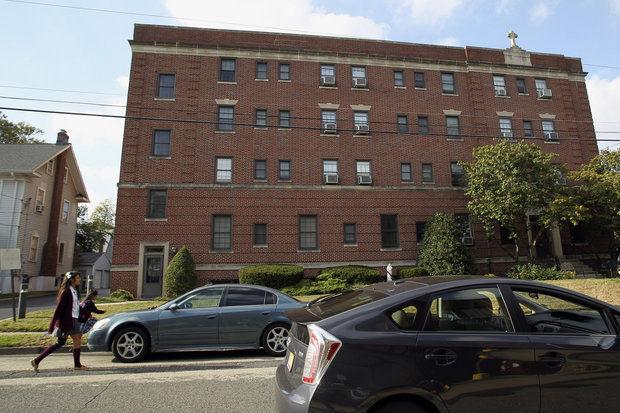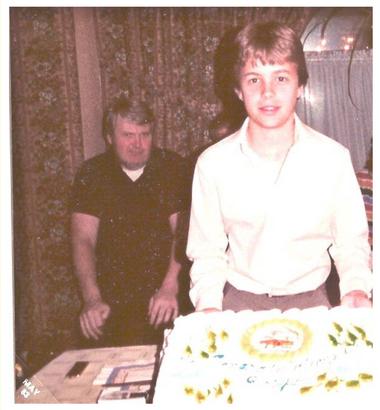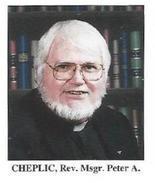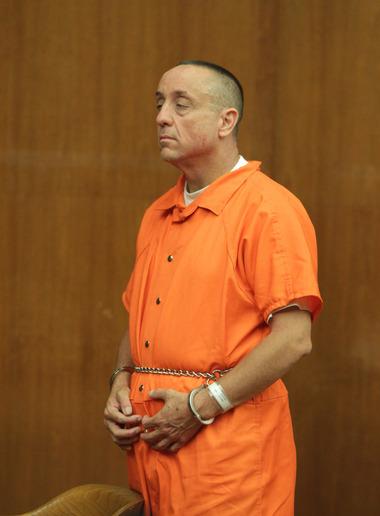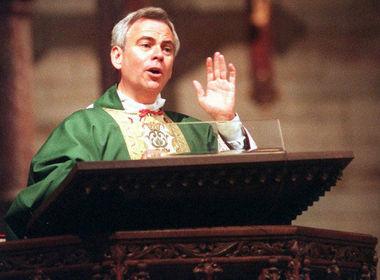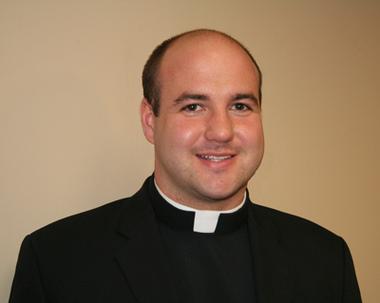Hidden Priests, Secret Pasts: Church Silent about Where It Houses Credibly Accused Clerics
By Mark Mueller
Norberto Nierras says he saw the man with the shock of white hair all the time along Home Avenue, a residential block that teems with children from the Catholic elementary and high schools a few hundred yards away. The man, Nierras said, came and went as he pleased, strolling the Rutherford neighborhood or sitting on a bench outside the four-story building he called home: the St. John Vianney Residence for Retired Priests. What Nierras didn’t know is that the man, the Rev. Msgr. Peter Cheplic, had been accused of drugging and molesting four teenage boys in the 1970s and 1980s. Or that the Archdiocese of Newark found the claims credible enough to remove him from ministry in 2006. Cheplic, who has denied the allegations, is one of at least seven alleged sexual predators quietly placed in the Rutherford retirement home in the past decade, The Star-Ledger found. Some lived there a short time. Others have stayed for years. Neighbors said they were never informed of the men’s presence until told by a reporter. "Parents need to be made aware of this," said Nierras, 25, who has lived across the street from St. John Vianney for more than three years. "There are kids around this area constantly. I’m pretty sure people would be upset. I’m upset." Eleven years after the nation’s bishops confronted the clergy sex abuse crisis, vowing at a landmark summit in Dallas to make the protection of children a priority and to open a new era of transparency, the church continues to wrestle with a host of vexing questions and competing interests. Does a credibly accused priest’s privacy trump public safety? Is the church capable of supervising alleged abusers? Should such priests even remain under the church’s care, drawing a salary, room and board? All of those questions apply to people like Cheplic, who was barred from public ministry but not criminally prosecuted because, by the time his accusers came forward, the deadline to charge him had expired under the statute of limitations. Across New Jersey’s five dioceses, dozens of priests are believed to be in the same sort of limbo. They include diocesan priests and clerics of religious orders, such as the Christian Brothers and the Benedictines. And they include priests who were barred from ministry in other states and have moved to or returned to New Jersey. One such priest, Robert Petrella, took up residence in North Arlington after two convictions for molesting children in Maryland, records show. Precisely how many others there are — and where most of them live — remains unclear, because the state’s bishops, by and large, refuse to publicly discuss the matter. The issues of supervision and transparency have taken on a renewed urgency in New Jersey this year following a series of revelations by The Star-Ledger about the Rev. Michael Fugee and other priests. Fugee, 52, was criminally charged in May after the newspaper disclosed he attended youth retreats and heard confessions from minors in violation of a court-sanctioned agreement to stay away from children. He has since been released on bail. Newark Archbishop John J. Myers and his spokesman, Jim Goodness, would not comment for this story, declining to say if other accused priests lived in the Rutherford residence or in a second retirement home for priests in Caldwell. The Star-Ledger found at least two accused clerics lived in Caldwell, address records show. That facility, too, is next to a Catholic elementary school, Trinity Academy, on the grounds of St. Aloysius Parish. A Monitoring System With Limitations The newspaper posed more than a dozen questions about supervision and transparency to New Jersey’s bishops. Paterson Bishop Arthur Serratelli declined comment. A spokesman for Camden Bishop Dennis Sullivan referred the newspaper to its website. The site contains the diocese’s policies for child protection, links to county prosecutors’ offices and statements about priests who have been removed from ministry over abuse allegations. The site does not specify what has become of those men. Spokeswomen for Trenton Bishop David M. O’Connell and Metuchen Bishop Paul Bootkoski issued statements that did not address the number of priests under supervision or where they are housed. O’Connell’s spokeswoman, Rayanne Bennett, said the diocese immediately notifies law enforcement of abuse allegations and alerts pastors and the public to suspensions. The diocese also works to ensure suspended priests do not have access to parish or school communities, Bennett said. "The diocese makes every reasonable effort to maintain contact with the priest and exercise ongoing oversight," she said. "However, the diocese has no legal power to control the individual’s place of residence or daily activities beyond the context of ministry." Bootkoski’s spokeswoman, Erin Friedlander, said the diocese "continues to seek out best practices for monitoring priests removed from ministry." That effort, she said, takes into account the "dual values of protecting children and of upholding the church’s legal principle that persons accused of crimes are innocent until proven guilty." While Goodness would not discuss the issue, he did provide some information about supervision in an e-mail sent last month to pastors and administrators of Catholic schools to alert them this story was in progress. The newspaper has obtained a copy of the e-mail, in which Goodness said he expected "a significant amount of inaccuracy, misconclusions and polemics." Goodness wrote that 15 priests are currently under supervision and that four others whom Myers removed from ministry since 2001 have died. The surviving priests must submit "periodic" written reports of their activities to the archdiocese. In recent years, Goodness wrote, the program has been expanded to include regular phone contact between the alleged abusers and the archdiocese’s minister for priests. "In addition," he wrote, "all clergy in the monitoring program are expressly advised that they cannot enter any school or facility offering any programs for youth or children." But clearly, the system has limitations, as Fugee demonstrated by openly spending time with members of the youth group at St. Mary’s Parish in Colts Neck. The church’s pastor, two youth ministers and the archdiocese’s vicar general, or second in command to Myers, have since been removed. In July, The Star-Ledger disclosed that the archdiocese allowed the Rev. Robert Chabak to live at an Oradell parish for several months after his Ocean County home was damaged by Hurricane Sandy. Neither the archdiocese nor the pastor informed parishioners of his background. Chabak was removed from ministry in 2004 for allegedly molesting a boy over a three-year span. When a few members of the parish raised an outcry, Chabak was transferred to the retirement home in Rutherford. He has since moved back to his private residence. O’Connell, the Trenton bishop, also came under fire last month after it was revealed that for more than a year, he declined to tell a parish in Jackson why an assistant pastor, the Rev. Matthew Riedlinger, had been pulled from the church. The bishop did so only after he learned The Star-Ledger was preparing a story about Riedlinger, who had been accused of sexually harassing several young men and engaging in explicit sexual conversations with someone he thought to be a 16-year-old boy. After the story ran, O’Connell suspended Riedlinger from ministry. Observers from inside and outside the priesthood say the church has made enormous improvements in child safety since the 2002 summit in Dallas. An annual audit conducted on behalf of the U.S. Conference of Catholic Bishops found that in 2012, allegations against priests had dropped to their lowest level since data collection began in 2004. At the same time, the observers say the incidents in New Jersey, along with others across the country, show that some bishops continue to operate too secretively and, as a result, put children at risk. "Even though they pledged to be transparent in Dallas, here we are in 2013 and they’re not being forthright about who their offenders are," said canon lawyer Patrick Wall, a former priest and Benedictine monk who now works for a Minnesota law firm that frequently sues the church over abuse allegations. "The bishops have chosen to say the right words, but they have not followed through with their actions," Wall said. "Until the day that cardinals and archbishops start going to jail, nothing is fundamentally going to change in the United States." 'We Should Have Been Told' The St. John Vianney retirement home in Rutherford opened in 1982. With four floors of two-room suites, it has space for about 22 priests, according to the archdiocese’s website. A roof deck provides expansive views of the surrounding neighborhood. Mass is said in a small chapel. Down the street sits St. Mary High School and the Academy at St. Mary, which educates students from kindergarten through eighth grade. Anthony Escolin, whose son graduated from the academy, has lived across the street from the two schools for seven years. Escolin, 56, called them good neighbors, noting someone even knocked on his door to warn him about excess noise during a construction project. But he has heard nothing from the archdiocese about the men cycling through St. John Vianney. "It would have been nice to have that information so we could protect ourselves and our kids," Escolin said. "We should have been told." The Star-Ledger identified accused priests who have lived at the retirement home in recent years by reviewing public address records and by interviewing visitors, including other priests. Neighbors also identified several priests from photos. The accusations against the men have been previously documented by The Star-Ledger and other news organizations. Among the residents: • The Rev. John Komar moved in at least six years ago, records show. Komar, now 75, was arrested in 2003 for viewing child pornography on a computer at Englewood Hospital and Medical Center, where he served as chaplain. • The Rev. Robert Morel, 70, was removed from ministry in 1993 for fondling a teenage boy. He later pleaded guilty and was sentenced to six months’ probation. Separately, he was named in a civil suit alleging he sexually abused a boy for eight years. • The Rev. Eugene Heyndricks, who had been assigned to parishes in Bergen and Hudson counties, was arrested in 2002 for soliciting sex from an underage male prostitute while visiting Montreal. Heyndricks pleaded guilty and was sentenced to two years’ probation. He has since died. • The Revs. Edward J. Eilert and Joseph Rice were accused in 2002 of sexually abusing a teenage girl in the 1980s. The Union County Prosecutor’s Office declared the allegations credible but said it could not bring charges because it was beyond the time allowed under the statute of limitations. Phillipsburg attorney Greg Gianforcaro, who filed suit against Rice on behalf of other alleged victims, visited the priest in Rutherford in the fall of 2010 to ask him questions related to one of the cases. "I just could not understand how the archdiocese could house any pedophile priest so close to one of its schools," Gianforcaro said. "I was stunned." The others identified by The Star-Ledger were Chabak, who was transferred to Rutherford for several months after complaints from parishioners in Oradell, and Cheplic, who was credibly accused of molesting four teenage boys. Joe Capozzi was one of those alleged victims. Now 44 and living in Manhattan, Capozzi was 16 when Cheplic allegedly began abusing him at St. Matthew’s Church in Ridgefield. Capozzi reached a settlement with the Archdiocese of Newark in 2006. He said Cheplic has demonstrated he should be nowhere near children, and he called it outrageous that the archdiocese had placed him so close to two schools. Capozzi also contends priests should not be entrusted with watching over one another. "They can’t police themselves," Capozzi said. "They prove it time and time again. They still consider themselves their own little world." That view is shared even by some priests, who point to the recent scandals in New Jersey as evidence. Chabak, for example, continued to spend nights at St. Joseph Roman Catholic Church in Oradell after the archdiocese transferred him to Rutherford, parishioners told The Star-Ledger. Chabak and the pastor at the time, Thomas Iwanowski, are longtime friends and own property together in Normandy Beach, records show. Despite the church’s finding that the allegation against Chabak was credible, Iwanowski has defended his friend, saying he did not believe Chabak had abused a child. Iwanowski has since been removed as pastor. A similar scenario played out with Fugee, who, even after his arrest and release on bail, continued to spend nights at Holy Family Church in Nutley, parishioners told the newspaper. Fugee and the pastor, the Rev. Msgr. Paul Bochicchio, are good friends and travel companions, and Bochicchio has steadfastly proclaimed Fugee’s innocence in the parish bulletin. Last month, Bochicchio was placed on sabbatical. The Rev. Thomas Reese, a senior analyst for the National Catholic Reporter and the former editor of America, a Catholic magazine, said it is "nonsense" to believe pastors, already overworked, can properly supervise priests who have been credibly accused of abuse. "He can’t act like a probation officer for another priest," Reese said. "He has neither the training nor the time." The conflict is exacerbated if pastor and priest are friends, Reese said. "If you’re friends with the alleged criminal, you’re in denial, just like any family is," he said. In general, Reese is not wholly unsympathetic to the church’s position, particularly when it is confronted with elderly or ailing priests who committed abuses decades before. "Sometimes there are extenuating circumstances," Reese said. "If you’ve got a guy who did this 30 years ago and now he’s in a rest home with Alzheimer’s disease, are you going to take away his pension and wheel him to the sidewalk? This is complicated stuff." Some bishops move immediately to laicize credibly accused clergy members, or kick them out of the priesthood altogether, Reese said. But that response, too, has drawn little consensus because of the obvious danger: potential predators released into communities, typically with no supervision at all. "What we’ve learned is that this is not a sin or a disease that can be treated," said Wall, the former priest who now serves as a victims’ advocate for the Minnesota law firm. "This is a true psychic infirmity, and the only way to treat it is to remove them from their target population." Wall suggests bishops return to a tactic the church used for centuries to keep predatory priests bottled up: isolating them in monasteries for a "life of prayer and penance." Hundreds of such monasteries exist across the country, he said. An alternative is to widely publicize the names and photos of credibly accused priests, alerting the public to potential danger. Advocates for victims of clergy sexual abuse have repeatedly called on New Jersey’s bishops to do just that, citing the church’s pledge of transparency. Mark Crawford, the New Jersey director of the Survivors Network of those Abused by Priests, a national advocacy and support group, said the bishops’ response has been, at best, half-hearted, and he pointed to his own experience in the Archdiocese of Newark as an example. Crawford and his younger brother were allegedly abused as children by the Rev. Kenneth L. Martin, then an associate pastor at St. Andrew’s Parish in Bayonne. Martin, now 64, resigned from ministry in 2002, and while he remains a priest, he is barred from serving as one and from wearing clerical garb, said Goodness, the archdiocese spokesman. Yet the archdiocese has never publicized Martin’s past. Today, he works as a train conductor for NJ Transit, a spokesman for the agency confirmed. Asked if NJ Transit had been aware of Martin’s background, the spokesman, Bill Smith, said all prospective employees undergo background checks that include searches for criminal records. In Martin’s case, it was beyond the statute of limitations. Crawford contends it is particularly important to publicize the names of credibly accused abusers in the absence of a criminal conviction, which provides some measure of public awareness. "Just because the statute of limitations has passed, it doesn’t mean these people are not still a threat," he said. "It is reckless for our bishops not to take the next step and warn others. But they continue to do it because they suffer no consequence."
|
.
Any original material on these pages is copyright © BishopAccountability.org 2004. Reproduce freely with attribution.
